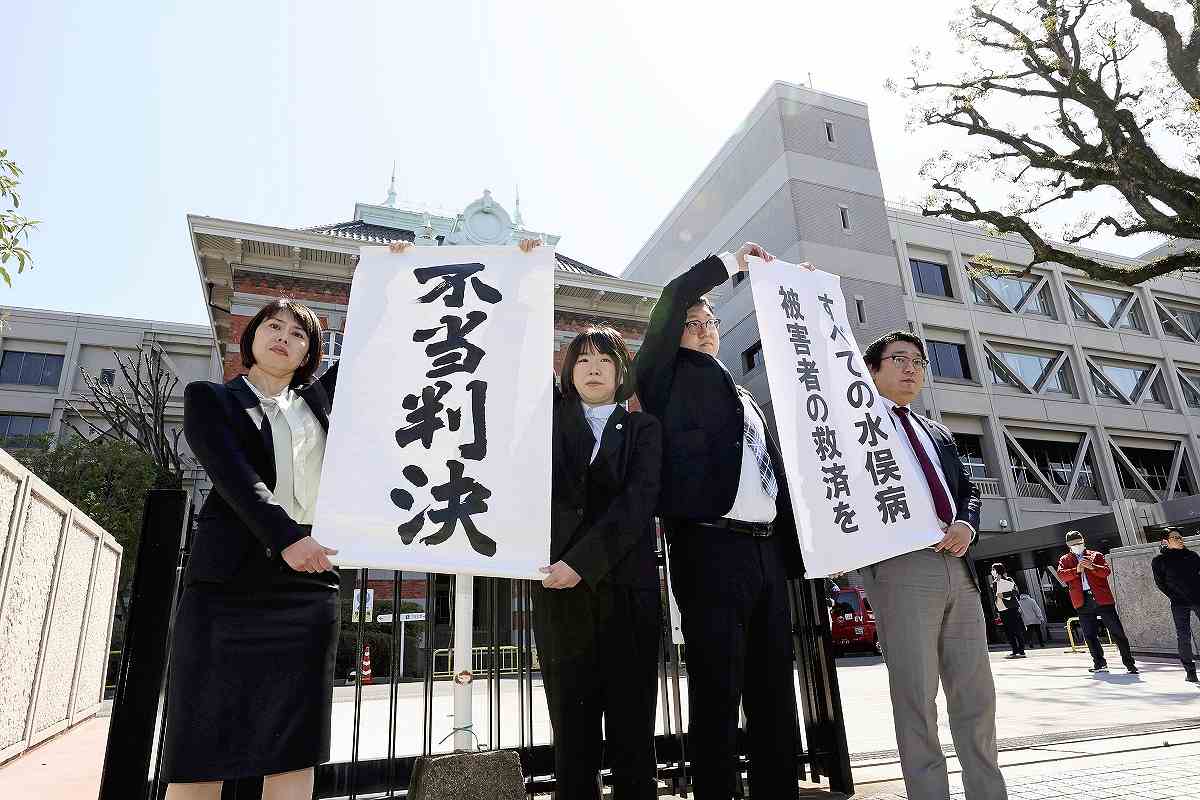
A piece of paper reading “Unjust judgment” is held up in front of the Kumamoto District Court at around 11 a.m. on Friday in Kumamoto City.
20:00 JST, March 22, 2024
KUMAMOTO — The Kumamoto District Court dismissed Friday a lawsuit filed by 144 plaintiffs who were excluded from receiving lump-sum payments under the Minamata disease special relief law.
The plaintiffs — including residents of Kumamoto and Kagoshima prefectures who had not been recognized as Minamata disease sufferers by law — had demanded ¥4.5 million per person in damages from the central government, the Kumamoto prefectural government and chemical maker Chisso Corp., whose polluted industrial wastewater caused Minamata disease, a form of mercury poisoning.
On Friday, the presiding judge recognized 25 of the 144 plaintiffs as sufferers of Minamata disease but dismissed all of their cases by applying the statute of limitations — under which the court ruled the right to demand compensation expires 20 years after an illegal act.
Chisso stopped discharging mercury into the sea in 1968.
Lawsuits making similar claims have been filed in four district courts nationwide. An Osaka District Court ruling in September — the first judicial decision in this group of cases — recognized plaintiffs who were not covered b the law as actual sufferers of the disease, and ordered the government and other parties to pay compensation.
The Osaka court’s ruling rejected a defense argument for invoking the 20-year statute of limitations, as the court regarded the countdown for the plaintiffs’ claims to have begun only in 2006, when medical examinations were conducted for the lawsuits, instead of the year of an illegal act.
The ruling by the Kumamoto court on Friday thus stands in contradiction to the ruling by the Osaka court in September.
The relief law went into effect in 2009, and about 55,000 people received compensation, while 9,600 were deemed “ineligible” for relief. The lawsuit was filed in June 2013 with the Kumamoto district court by people in the latter group.
The main point of contention was whether the plaintiffs, who complained of sensory disturbances in their hands and feet, were suffering from Minamata disease. The validity of the conditions for eligibility under the relief law — such as area place of residence and date of birth — was also contested.
The plaintiffs claimed that fish and shellfish caught in the Yatsushiro Sea (also known as Shiranui Sea) — waters of western Kyushu that include Minamata Bay — were contaminated with mercury, and that they ate a lot of poisoned fish and shellfish even while outside the target area and a doctor’s diagnosis confirmed that they had Minamata disease.
The defendants countered that contaminated seafood was not distributed in large quantities outside the target area away from Chisso’s Minamata factory, and there was no contamination after the factory stopped the release of polluted water.
"Society" POPULAR ARTICLE
-

M4.9 Earthquake Hits Tokyo, Neighboring Prefectures
-

Israeli Tourists Refused Accommodation at Hotel in Japan’s Nagano Pref., Prompting Protest by Israeli Embassy and Probe by Prefecture
-

M7.5 Earthquake Hits Northern Japan; Tsunami Waves Observed in Hokkaido, Aomori and Iwate Prefectures
-

Tsukiji Market Urges Tourists to Avoid Visiting in Year-End
-

High School in Kyoto Says Students Shoplifted during Recent School Trip to Bali, Indonesia
JN ACCESS RANKING
-

Tokyo Economic Security Forum to Hold Inaugural Meeting Amid Tense Global Environment
-

Keidanren Chairman Yoshinobu Tsutsui Visits Kashiwazaki-Kariwa Nuclear Power Plant; Inspects New Emergency Safety System
-

Imports of Rare Earths from China Facing Delays, May Be Caused by Deterioration of Japan-China Relations
-

University of Tokyo Professor Discusses Japanese Economic Security in Interview Ahead of Forum
-

Japan Pulls out of Vietnam Nuclear Project, Complicating Hanoi’s Power Plans

























